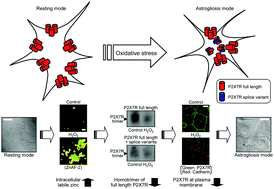当前位置:
X-MOL 学术
›
Metallomics
›
论文详情
Our official English website, www.x-mol.net, welcomes your
feedback! (Note: you will need to create a separate account there.)
Oxidative stress-induced increase of intracellular zinc in astrocytes decreases their functional expression of P2X7 receptors and engulfing activity†
Metallomics ( IF 2.9 ) Pub Date : 2017-12-01 00:00:00 , DOI: 10.1039/c7mt00257b Takahiro Furuta 1, 2, 3, 4 , Ayumi Mukai 1, 2, 3, 4 , Akihiro Ohishi 1, 2, 3, 4 , Kentaro Nishida 1, 2, 3, 4 , Kazuki Nagasawa 1, 2, 3, 4
Metallomics ( IF 2.9 ) Pub Date : 2017-12-01 00:00:00 , DOI: 10.1039/c7mt00257b Takahiro Furuta 1, 2, 3, 4 , Ayumi Mukai 1, 2, 3, 4 , Akihiro Ohishi 1, 2, 3, 4 , Kentaro Nishida 1, 2, 3, 4 , Kazuki Nagasawa 1, 2, 3, 4
Affiliation

|
Neuron–glia communication mediated by neuro- and glio-transmitters such as ATP and zinc is crucial for the maintenance of brain homeostasis, and its dysregulation is found under pathological conditions. It is reported that under oxidative stress-loaded conditions, astrocytes exhibit increased intra- and extra-cellular labile zinc, the latter triggering microglial M1 activation, while the pathophysiological role of the former remains unrevealed. In this study, we examined whether the oxidative stress-induced increase of intracellular labile zinc is involved in the P2X7 receptor (P2X7R)-mediated regulation of astrocytic engulfing activity. The exposure of cultured astrocytes to sub-lethal oxidative stress through their treatment with 400 μM H2O2 increased intracellular labile zinc, of which the concentration reached a peak level of approximately 2 μM at 2 h after the treatment. In astrocytes under sub-lethal oxidative stress, the uptake of YO-PRO-1 and latex beads as markers for P2X7R channel/pore activity and astrocytic engulfing activity, respectively, was decreased, and these decreased activities were accompanied by decreased expression of P2X7R at the plasma membrane via intracellular labile zinc-mediated translocation of it. With the oxidative stress, the expression level of full length P2X7R relative to that of its splice variants in astrocytes was decreased, leading to a decrease of the relative expression of the trimer consisting of full length P2X7R. Collectively, sub-lethal oxidative stress induces an astrocytic modal shift from the normal resting engulfing mode to the activated astrogliosis mode via an intracellular labile zinc-mediated decrease of the functional expression of P2X7R.
中文翻译:

氧化应激诱导星形胶质细胞内锌的增加会降低其P2X7受体的功能性表达和吞噬活性†
由神经递质和神经胶质递质(如ATP和锌)介导的神经元-胶质细胞交流对于维持脑稳态至关重要,并且在病理情况下会发现其失调。据报道,在充满氧化应激的条件下,星形胶质细胞的细胞内和细胞外不稳定锌含量增加,后者触发小胶质细胞M1活化,而前者的病理生理作用仍未揭示。在这项研究中,我们检查了氧化应激诱导的细胞内不稳定锌的增加是否参与了P2X7受体(P2X7R)介导的星形胶质吞噬活性的调节。培养的星形胶质细胞通过用400μMH 2 O 2处理而暴露于亚致死性氧化应激中增加细胞内不稳定的锌,其浓度在处理后2小时达到约2μM的峰值水平。在亚致死性氧化应激下的星形胶质细胞中,分别减少了YO-PRO-1和乳胶珠作为P2X7R通道/孔活性和星形胶质吞噬活性的标志物的摄取,并且这些降低的活性伴随着P2X7R在质膜通过细胞内不稳定的锌介导的易位。随着氧化应激,星形胶质细胞中全长P2X7R与其剪接变体的表达水平降低,导致由全长P2X7R组成的三聚体的相对表达降低。总的来说,亚致死性氧化应激通过细胞内不稳定的锌介导的P2X7R功能性表达下降,导致星形胶质细胞从正常静止吞噬模式转变为活化的星形胶质增生模式。
更新日期:2017-12-01
中文翻译:

氧化应激诱导星形胶质细胞内锌的增加会降低其P2X7受体的功能性表达和吞噬活性†
由神经递质和神经胶质递质(如ATP和锌)介导的神经元-胶质细胞交流对于维持脑稳态至关重要,并且在病理情况下会发现其失调。据报道,在充满氧化应激的条件下,星形胶质细胞的细胞内和细胞外不稳定锌含量增加,后者触发小胶质细胞M1活化,而前者的病理生理作用仍未揭示。在这项研究中,我们检查了氧化应激诱导的细胞内不稳定锌的增加是否参与了P2X7受体(P2X7R)介导的星形胶质吞噬活性的调节。培养的星形胶质细胞通过用400μMH 2 O 2处理而暴露于亚致死性氧化应激中增加细胞内不稳定的锌,其浓度在处理后2小时达到约2μM的峰值水平。在亚致死性氧化应激下的星形胶质细胞中,分别减少了YO-PRO-1和乳胶珠作为P2X7R通道/孔活性和星形胶质吞噬活性的标志物的摄取,并且这些降低的活性伴随着P2X7R在质膜通过细胞内不稳定的锌介导的易位。随着氧化应激,星形胶质细胞中全长P2X7R与其剪接变体的表达水平降低,导致由全长P2X7R组成的三聚体的相对表达降低。总的来说,亚致死性氧化应激通过细胞内不稳定的锌介导的P2X7R功能性表达下降,导致星形胶质细胞从正常静止吞噬模式转变为活化的星形胶质增生模式。











































 京公网安备 11010802027423号
京公网安备 11010802027423号